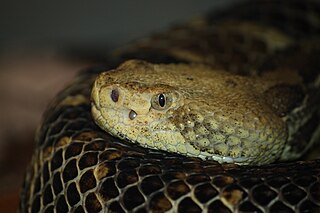
The Crotalinae, commonly known as pit vipers, or pit adders, are a subfamily of vipers found in Asia and the Americas. Like all other vipers, they are venomous. They are distinguished by the presence of a heat-sensing pit organ located between the eye and the nostril on both sides of the head. Currently, 23 genera and 155 species are recognized: These are also the only viperids found in the Americas. The groups of snakes represented here include rattlesnakes, lanceheads, and Asian pit vipers. The type genus for this subfamily is Crotalus, of which the type species is the timber rattlesnake, C. horridus.

Bothrops atrox — also known as the common lancehead, fer-de-lance, barba amarilla and mapepire balsain — is a highly venomous pit viper species found in the tropical lowlands of northern South America east of the Andes, as well as the Caribbean island of Trinidad. No subspecies are currently recognized.
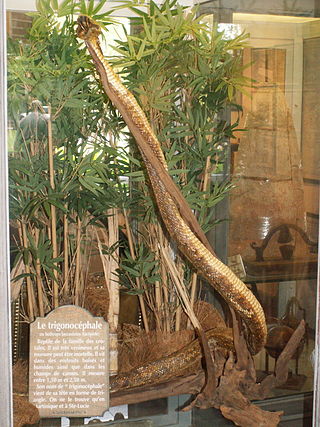
Bothrops lanceolatus — known as the fer-de-lance, Martinican pit viper, and Martinique lancehead — is a species of pit viper endemic to the Caribbean island of Martinique. Some reserve the common name fer-de-lance for this species, while others apply that name to other Bothrops species as well. No subspecies are currently recognized.

Bothrops alternatus is a highly venomous pit viper species found in South America. Within its range, it is an important cause of snakebite. The specific name, alternatus, which is Latin for "alternating", is apparently a reference to the staggered markings along the body. No subspecies are currently recognized.

The terciopelo is a species of pit vipers, found in Central to South Americas. At low to moderate elevations, its habitat ranges from northeastern Mexico to Colombian and Ecuadorian Andes, as well as Venezuela. With a mass of up to 6 kilograms (13 lb), and a maximal length of 2.5 metres (8.2 ft), the terciopelo is among the largest vipers. It is light to dark brown in color, often with yellowish, zig-zag patterning on either side of its body. Dubbed "the ultimate pit-viper" for its defensiveness, large size, fangs and potent venom yield, it has a fearsome reputation, responsible for the most envenomated snakebites within its range, largely due to its proximity to humans, livestock and pets. Nonetheless, like all venomous snakes, the terciopelo actively avoids contact with humans and larger animals, with bites generally only occurring when the snake is cornered, pursued, or threatened. No subspecies are currently recognized.

Bothriechis is a genus of pit vipers, commonly called palm vipers or palm-pitvipers found predominantly in Mexico and Central America, although the most common species, B. schlegelii, ranges as far south as Colombia and Peru. All members are relatively slender and arboreal. The name Bothriechis is derived from the Greek words bothros and echis that mean "pit" and "viper" respectively. Ten species and no subspecies are currently generally recognized.

Bothriechis bicolor is a pit viper species found in southern Mexico, Guatemala and Honduras. The specific name refers to the contrasting ventral and dorsal colors. No subspecies are currently recognized.

Metlapilcoatlus nummifer, commonly known as Mexican jumping pitviper or jumping viper, is a venomous pit viper species endemic to Mexico.
Atropoides picadoi, also known as Picado's jumping pitviper, is a species of venomous snake, a pitviper in the subfamily Crotalinae of the family Viperidae. The species is endemic to Costa Rica. There are no subspecies that are recognised as being valid. It is monotypic in the genus Atropoides.

Bothriechis aurifer is a pit viper species found in Mexico and Guatemala. No subspecies are currently recognized.

Cerrophidion tzotzilorum is a venomous pit viper species which is native to southern Mexico. There are no subspecies that are recognized as being valid.
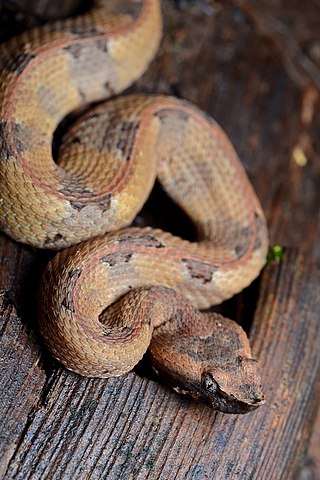
Porthidium nasutum is a venomous pitviper species found in southern Mexico, Central America and northern South America. No subspecies are currently recognized.
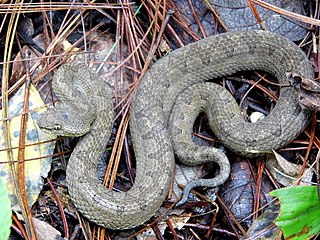
Ophryacus undulatus is a venomous pitviper species found in the mountains of central and southern Mexico. No subspecies are currently recognized.

Bothrops bilineatus, also known as the two-striped forest-pitviper, parrotsnake, Amazonian palm viper, or green jararaca, is a highly venomous pit viper species found in the Amazon region of South America. Two subspecies are currently recognized, including the nominate subspecies described here. A pale green arboreal species that may reach 1 m (3.3 ft) in length, it is an important cause of snakebite throughout the entire Amazon region.

Metlapilcoatlus mexicanus is a venomous pitviper species endemic to Mexico and Central America.
Metlapilcoatlus occiduus is a venomous pitviper subspecies endemic to southern Mexico, Guatemala, and El Salvador.
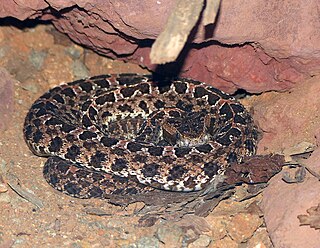
Porthidium ophryomegas is a venomous pitviper species found in Central America. No subspecies are currently recognized.
Bothrops medusa is a venomous pitviper species endemic to Venezuela. No subspecies are currently recognized.

Bothrops punctatus is a venomous pitviper species found in Ecuador, Mostly in the Chocó Department in Western Colombia and Panama. No subspecies are currently recognized.

Bothrocophias campbelli, commonly known as Campbell's toadheaded viper, the Ecuadorian toadheaded pitviper, and víbora boca de sapo in Spanish, is a species of venomous pitviper in the family Viperidae. The species is endemic to South America. No subspecies are currently recognized.


















